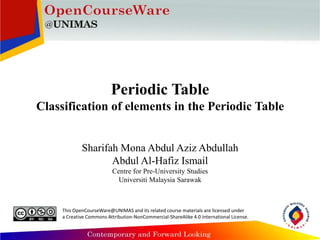Classification of Elements
•Download as PPTX, PDF•
6 likes•3,743 views
This document provides an overview of the periodic table and how elements are classified based on their properties and position. It discusses the organization of elements into periods and groups based on their atomic number and valence electrons. Elements are classified into three main categories - metals, non-metals, and metalloids. Specific groups are highlighted including alkali metals, alkaline earth metals, transition metals, halogens, and noble gases; and their key properties and positions in the periodic table are described in 1-2 sentences each.
Report
Share
Report
Share

Recommended
More Related Content
What's hot
What's hot (20)
Similar to Classification of Elements
Similar to Classification of Elements (20)
Unit b matter and chemical change notes(reading periodic table)

Unit b matter and chemical change notes(reading periodic table)
Recently uploaded
Recently uploaded (20)
Biogenic Sulfur Gases as Biosignatures on Temperate Sub-Neptune Waterworlds

Biogenic Sulfur Gases as Biosignatures on Temperate Sub-Neptune Waterworlds
Seismic Method Estimate velocity from seismic data.pptx

Seismic Method Estimate velocity from seismic data.pptx
Locating and isolating a gene, FISH, GISH, Chromosome walking and jumping, te...

Locating and isolating a gene, FISH, GISH, Chromosome walking and jumping, te...
Asymmetry in the atmosphere of the ultra-hot Jupiter WASP-76 b

Asymmetry in the atmosphere of the ultra-hot Jupiter WASP-76 b
Introduction,importance and scope of horticulture.pptx

Introduction,importance and scope of horticulture.pptx
Pests of mustard_Identification_Management_Dr.UPR.pdf

Pests of mustard_Identification_Management_Dr.UPR.pdf
Justdial Call Girls In Indirapuram, Ghaziabad, 8800357707 Escorts Service

Justdial Call Girls In Indirapuram, Ghaziabad, 8800357707 Escorts Service
❤Jammu Kashmir Call Girls 8617697112 Personal Whatsapp Number 💦✅.

❤Jammu Kashmir Call Girls 8617697112 Personal Whatsapp Number 💦✅.
Feature-aligned N-BEATS with Sinkhorn divergence (ICLR '24)

Feature-aligned N-BEATS with Sinkhorn divergence (ICLR '24)
Module for Grade 9 for Asynchronous/Distance learning

Module for Grade 9 for Asynchronous/Distance learning
Classification of Elements
- 1. Periodic Table Classification of elements in the Periodic Table Sharifah Mona Abdul Aziz Abdullah Abdul Al-Hafiz Ismail Centre for Pre-University Studies Universiti Malaysia Sarawak This OpenCourseWare@UNIMAS and its related course materials are licensed under a Creative Commons Attribution-NonCommercial-ShareAlike 4.0 International License.
- 2. Introduction The periodic table shows all of the known elements in order of increasing atomic number. Horizontal row of periodic table is called period. Periods are arranged horizontally across the periodic table, labeled as rows 1 – 7. These elements have the same number of valence shells.
- 3. The periodic table is organized to group elements with similar properties in vertical columns. Groups are arranged vertically down the periodic table, labeled as column 1 – 18. These elements have the same number electrons in the outer most shells, the valence shell. Introduction
- 4. Elements can be grouped into 3 classes based on their general properties: Metal – shiny and conduct electricity Non-metal – do not conduct electricity Metalloids – semiconductors Introduction
- 6. Elements can be grouped into 3 classes based on their general properties: Metal – shiny and conduct electricity Non-metal – do not conduct electricity Metalloids – semiconductors Introduction
- 7. Main categories of elements Metals Non-metals Metalloids
- 9. Alkali Metals They are in group 1 of periodic table (except Hydrogen) They are shiny, soft and can be cut with a knife They have 1 valence electron The most reactive metals (react violently with water) Reactivity increasing down the group Never found as free elements in nature Li Na K Rb Cs Fr
- 10. Alkaline Earth Metal They are in Group 2 of periodic table They are less reactive than alkali metal They are shiny and silvery-white in colour They have 2 valence electrons Thay are never found uncombined in nature. Be Mg Ca Sr Ba Ra
- 11. Transition Metals They are in Group 3 to 12 of periodic table Good conductors of heat and electricity The compounds of transition metals are usually brightly coloured Have variable oxidation number Sc Ti V Cr Mn Fe Co Ni Cu Zn
- 12. Halogens They are in Group 17 of periodic table. They have 7 valence electron The most reactive of the non-metals React with alkali metal to form salts. Reactivity decreasing down the group F Cl Br I At
- 13. Noble Gas They are in group 18 of the periodic table. Also known as inert gases All exist in gases at room temperature Non-reactive because they have a full valence shell (which is 8) He Ne Ar Kr Xe Rn